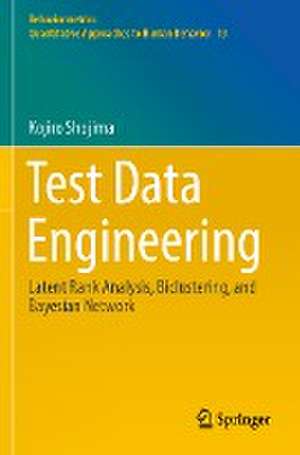Test Data Engineering: Latent Rank Analysis, Biclustering, and Bayesian Network: Behaviormetrics: Quantitative Approaches to Human Behavior, cartea 13
Autor Kojiro Shojimaen Limba Engleză Paperback – 15 aug 2023
| Toate formatele și edițiile | Preț | Express |
|---|---|---|
| Paperback (1) | 904.60 lei 6-8 săpt. | |
| Springer Nature Singapore – 15 aug 2023 | 904.60 lei 6-8 săpt. | |
| Hardback (1) | 910.89 lei 6-8 săpt. | |
| Springer Nature Singapore – 14 aug 2022 | 910.89 lei 6-8 săpt. |
Din seria Behaviormetrics: Quantitative Approaches to Human Behavior
- 18%
 Preț: 780.82 lei
Preț: 780.82 lei - 18%
 Preț: 953.65 lei
Preț: 953.65 lei - 18%
 Preț: 775.96 lei
Preț: 775.96 lei - 15%
 Preț: 633.02 lei
Preț: 633.02 lei - 18%
 Preț: 777.20 lei
Preț: 777.20 lei - 15%
 Preț: 692.24 lei
Preț: 692.24 lei - 15%
 Preț: 688.16 lei
Preț: 688.16 lei - 18%
 Preț: 892.59 lei
Preț: 892.59 lei - 18%
 Preț: 1124.78 lei
Preț: 1124.78 lei - 18%
 Preț: 892.90 lei
Preț: 892.90 lei - 18%
 Preț: 943.43 lei
Preț: 943.43 lei - 18%
 Preț: 1116.57 lei
Preț: 1116.57 lei - 18%
 Preț: 790.28 lei
Preț: 790.28 lei - 18%
 Preț: 773.20 lei
Preț: 773.20 lei - 18%
 Preț: 940.25 lei
Preț: 940.25 lei - 18%
 Preț: 888.01 lei
Preț: 888.01 lei - 18%
 Preț: 718.65 lei
Preț: 718.65 lei - 26%
 Preț: 405.88 lei
Preț: 405.88 lei - 26%
 Preț: 524.35 lei
Preț: 524.35 lei
Preț: 904.60 lei
Preț vechi: 1103.16 lei
-18% Nou
Puncte Express: 1357
Preț estimativ în valută:
173.11€ • 179.64$ • 144.69£
173.11€ • 179.64$ • 144.69£
Carte tipărită la comandă
Livrare economică 15-29 martie
Preluare comenzi: 021 569.72.76
Specificații
ISBN-13: 9789811699887
ISBN-10: 9811699887
Ilustrații: XXII, 579 p. 242 illus., 216 illus. in color.
Dimensiuni: 155 x 235 mm
Greutate: 0.84 kg
Ediția:1st ed. 2022
Editura: Springer Nature Singapore
Colecția Springer
Seria Behaviormetrics: Quantitative Approaches to Human Behavior
Locul publicării:Singapore, Singapore
ISBN-10: 9811699887
Ilustrații: XXII, 579 p. 242 illus., 216 illus. in color.
Dimensiuni: 155 x 235 mm
Greutate: 0.84 kg
Ediția:1st ed. 2022
Editura: Springer Nature Singapore
Colecția Springer
Seria Behaviormetrics: Quantitative Approaches to Human Behavior
Locul publicării:Singapore, Singapore
Cuprins
Concept of Test Data Engineering.- Test Data and Item Analysis.- Classical Test Theory.- Item Response Theory.- Latent Class Analysis.- Biclustering.- Bayesian Network Model.
Notă biografică
Kojiro Shojima is Associate Professor at The National Center for University Entrance Examinations. He is a psychometrician living in Tokyo with his (lovely) wife and two (angelic) daughters.
Textul de pe ultima copertă
This is the first technical book that considers tests as public tools and examines how to engineer and process test data, extract the structure within the data to be visualized, and thereby make test results useful for students, teachers, and the society. The author does not differentiate test data analysis from data engineering and information visualization. This monograph introduces the following methods of engineering or processing test data, including the latest machine learning techniques: classical test theory (CTT), item response theory (IRT), latent class analysis (LCA), latent rank analysis (LRA), biclustering (co-clustering), and Bayesian network model (BNM). CTT and IRT are methods for analyzing test data and evaluating students’ abilities on a continuous scale. LCA and LRA assess examinees by classifying them into nominal and ordinal clusters, respectively, where the adequate number of clusters is estimated from the data. Biclustering classifies examinees into groups (latent clusters) while classifying items into fields (factors). Particularly, the infinite relational model discussed in this book is a biclustering method feasible under the condition that neither the number of groups nor the number of fields is known beforehand. Additionally, the local dependence LRA, local dependence biclustering, and bicluster network model are methods that search and visualize inter-item (or inter-field) network structure using the mechanism of BNM. As this book offers a new perspective on test data analysis methods, it is certain to widen readers’ perspective on test data analysis.
Caracteristici
Demonstrates how test data can be engineered to transform it into information useful for examinees and teachers Shows how information underlying the test data can be visualized after structuring and extracting it Expands readers’ field of vision in analyzing test data by demonstrating various useful statistical models
